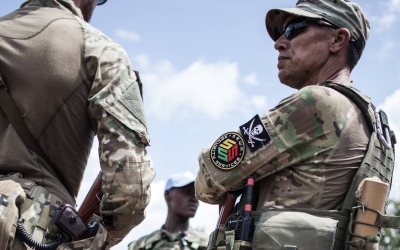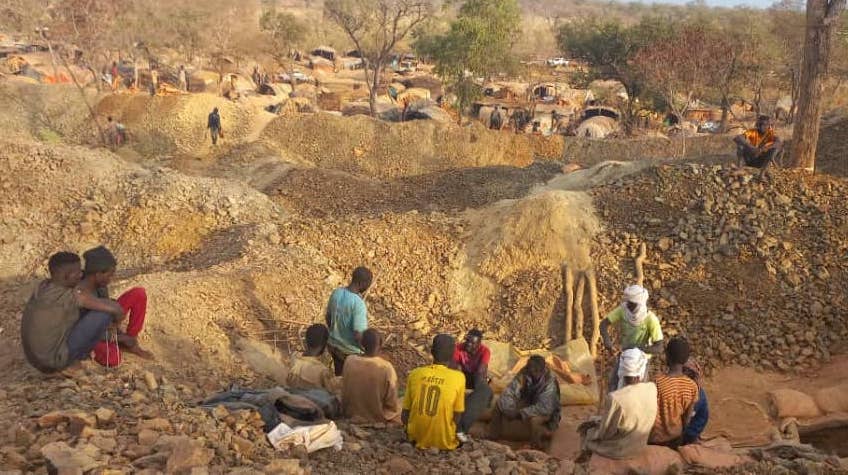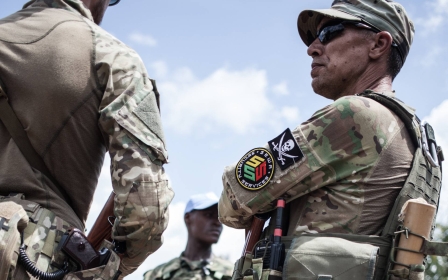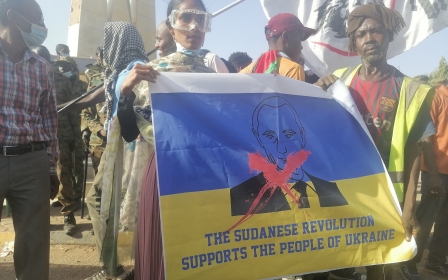Darfur village left reeling from Wagner Group's CAR massacre
Mariam Obaid did not get a chance to say goodbye. Her 20-year-old son Nizar Musa Ali Hamad was among the more than 100 gold miners from Sudan, Chad, Niger, and the Central African Republic (CAR) killed in a massacre in March.
Even at this young age, Nizar had taken on sole responsibility for supporting his family. Obaid, who is from the Darfur region of Sudan, told Middle East Eye her son had been buried by colleagues in CAR after Russian mercenaries from the Wagner Group perpetrated the mass killing in the Andaha area of CAR.
'No-one is helping us now. We lost our sons because of those Russian fighters'
- Mariam Obaid, mother
Colleagues and other family members corroborated the story. An unknown number of gold miners have gone missing in recent months as Russian mercenaries, working with local militias and the CAR government, have increased their presence in the mining areas of this part of Africa.
Survivors are now appearing in Sudan, having crossed over the border into Darfur after walking vast distances from CAR or through Chad.
The Sudanese victims fleeing the attack, who are from different parts of Darfur, have told MEE that the attacks, spearheaded by Wagner forces, began on 23 March and have continued sporadically, pushing thousands of those targeted to flee through Chad into Sudan, often walking for days on end.
New MEE newsletter: Jerusalem Dispatch
Sign up to get the latest insights and analysis on Israel-Palestine, alongside Turkey Unpacked and other MEE newsletters
The eldest son
“My son has been killed by the gunmen in Andaha, he has been lost since the beginning and we consider him among the disappeared,” Obaid said. “He has been killed there and buried there. All his properties, money, and gold have been looted.”
Obaid said her son’s cousins were in CAR and that they had told her they buried Nizar after he was killed “by the mercenaries”.
“Nizar was the oldest of his six brothers. He has taken care of this family since his father died a few months ago. This means we are alone without anyone to take care of his brothers and sisters,” Obaid told MEE, as she tearfully blamed Russian fighters for killing her son and the relatives of other families in her village.
That village is Blubol, which lies about 90 km north of Nyala, the capital of South Darfur state. Obaid, known as “Marioma” to her friends, is not the only mother in the village to have lost a child in neighbouring CAR.
Funeral after funeral has taken place since the March massacre, with more ceremonies in the offing and other families still worried about the fate of their sons.
Abakar Mohamed, 30, also went from Blubol to Andaha, where he witnessed the attack. “The majority of the village’s families have lost one of their relatives - or have someone who has gone missing - in CAR,” he told MEE.
“No one is helping us now. We lost our sons because of those Russian fighters. That was very brutal and painful,” Obaid said.
“You see many houses in this village that are sad and full of pain. Their sons want to make this small business to take care of their families because of the poverty and instability in Darfur, but they have been killed for reasons that are not known to us,” she told MEE. “I didn't even get a chance to see my son before he was buried.”
Eyewitnesses and gold miners told MEE last month that mercenary fighters believed to be belonging to Wagner Group attacked them in Andaha, CAR, killing dozens of miners from countries across the region.
The witnesses who managed to flee the attack and reach relative safety in Sudan told stories about the brutality of the killings carried out by Wagner, saying that heavy weapons, including helicopters and tanks, were used.
The long walk to Sudan
According to eyewitnesses who recently reached Bulbol village and Nyala city in South Darfur, many of those who escaped the massacre were considered missing people and had only recently arrived because they walked all the way to Sudan via Chad.
They also said that some of those who had escaped the killings had died of thirst on the road, after walking for many days. Gazafi Ali Hamad, 40, was among the recent returnees who walked from CAR to Chad and finally crossed the border into Sudan in April.
“I was in the Andaha mining field when the Russians began the attack on 23 March, closing the road in the area of Seinkilo near Andaha and starting the random attack, killing and looting, so we fled in all directions,” he told MEE.

“As the Russian fighters closed the road in front of us, we couldn’t go directly to Sudan, especially since we were forced to leave all means of transport - including the motorbikes - behind. So we took the route that led to Chad and walked for nine days until we reached Chad, then walked for another two days to Sudan,” Hamad said.
“We were a group of 11 people,” he continued. “We left all our properties, gold, and money behind and just ran. We suffered a lot on the road as we didn’t have food or water. We didn’t drink any water for five days and we lost some of our colleagues.
“We finally reached a small Chadian river called Ouda, so we at least got the water and we also got some help from some Chadian villagers on the road. But that was the worst suffering I have faced in my life, I thought I would die on the way.”
Those who returned and those who escaped
Back in Darfur, some families told MEE of their delight and surprise to discover that loved ones they feared were dead had managed to escape and return home.
Aid workers said there had been an influx of refugees from CAR into Chad because of the continuous conflicts there. This has increased recently, they told MEE.
The workers, who asked not to be named because they are not authorised to talk to the media, said that the attacks perpetrated by mercenaries thought to be working for the Wagner Group had led to an increase in displacement from CAR into Um Dokhon, in Darfur.
“We heard a lot of stories about the attack of the Wagner forces on the miners from Sudan, Chad, and CAR, who then seek refugee in Sudan,” one of the workers confirmed.
Middle East Eye delivers independent and unrivalled coverage and analysis of the Middle East, North Africa and beyond. To learn more about republishing this content and the associated fees, please fill out this form. More about MEE can be found here.






